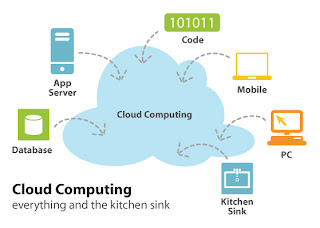“Cloud Computing is a paradigm in which information is permanently stored in servers on the internet and cached temporarily on clients that include desktops, entertainment centers, table computers, notebooks, wall computers, hand-helds, sensors, monitors, etc.” - 2008 IEEE paper
Like cell phones in the third world, the cloud will help many smaller companies access the types of services that used to be available only to the enterprise. If you're a small or medium sized business, this is the answer to your prayers.
While end users may never even know that the application they're using is coming from the cloud, IT will be completely transformed, and the business as a whole will have an entirely new way of viewing, using and paying for technology.
In the cloud computing definitions that are evolving, the services in the cloud are being provided by enterprises and accessed by others via the internet. The resources are accessed in this manner as a service – often on a subscription basis. The users of the services being offered often have very little knowledge of the technology being used. The users also have no control over the infrastructure that supports the technology they are using.
In addition, cloud computing opens up innovative ways to use rich-media capabilities, such as integrating video into documents or presentations. Web-based applications make it easy to publish the results of a single source file in many locations. For example, Read more: http://www.bench3.com/2009/11/introduction-to-cloud-computing-what-is.html
For IT, cloud computing is as significant a development as the invention of the PC, or as the effect of the iPod on the music industry.
Think of it as utility computing on steroids or services sold by the drink.
End users may never even know that the application they're using is coming from the cloud, IT will be completely transformed, and the business as a whole will have an entirely new way of viewing, using and paying for technology.
"Companies that are smart are taking a look at the varied aspects of cloud and pushing certain applications up (into the cloud) and those that need unique distinguishing characteristics they push down (into the traditional data center environment). IT has to realize that it's in kind of a precarious position. It can either accelerate this change and gain great glory or they can sit back in denial and just atrophy."
The most important value the cloud brings is not lower costs. It is improved agility, not just for IT, but for the business as a whole.
That agility comes from the option to offload any aspect of a company's IT infrastructure to an outside provider, paying only for the services you need as you need them.
There is a big push for cloud computing services by several big companies. Amazon.com has been at the forefront of the cloud computing movement. Google and Microsoft have also been very publicly working on cloud computing offerings. Some of the other companies to watch for in this field are Yahoo!, IBM, Intel, HP and SAP. Several large universities have also been busy with large scale cloud computing research projects.
As an example, Eli Lilly used Amazon's EC2 cloud offering to add 50 servers in a matter of days rather than weeks to assist in the development of a new drug. When any delay in a pharmaceutical project can cost $150 per second or more, that's a huge difference.
What's more, when the 50 servers were up and running, Neal says, they quickly discovered they actually needed 250. "But this is Amazon, so they changed 50 to 250 and clicked 'Go,' and ran the whole shebang that day," he says.
And that's the power of the cloud: no provisioning, no waiting, just click, pay, and you're done.
It's a real wake-up call for IT, promising to remove the barriers between CPUs and the services that depend on them. Think of it like Moore's Law — every 18 months, you should be able to double the level of cloud-based services you can offer - or like a RAID for CPUs: a bunch of cheap servers that can be provisioned as needed to handle any load.
Even if a server or two fails, it doesn't matter: everything just fails over as needed to the next available processor, and all that matters is the delivery of the service itself. Failure now becomes a routine way of operating and we just wire around it. Google has hard drives fail on a daily basis, Google has servers fail on a daily basis, and nobody cares.
Today's leading cloud computing vendors eschew high-end components and use large quantities of the cheapest hardware good enough to do the job. They assume some of this hardware will fail, so they use software that can adapt as necessary. This approach offers substantial savings in hardware costs, and even bigger ones with people.
Still, none of this means that you should close down your data center - the cloud is still relatively new, with many variables still waiting to be hammered out. It may be a decade or more before cloud-based business apps are the norm.
Advantages Of Cloud Computing:
- Low Cost (lower technology-based capital expenditures)
- Users can access systems no matter where they are located
- Improved performance and load balancing.
- Improved resource utilization
Dis-Advantage Of Cloud Computing:
- Cannot own the Technology, or the Infrastructure.
- Loss of control over data
- May affect reliability and scalability as there is not much control of the data
In cloud computing models, customers do not own the infrastructure they are using, they basically rent it, or pay as they use it. The loss of control is seen as a negative, but it is generally out-weighed by several positives. One of the major selling points of cloud computing is lower costs. Companies will have lower technology-based capital expenditures, which should enable companies to focus their money on delivering the goods and services that they specialize in.
There will be more device and location independence, enabling users to access systems no matter where they are located or what kind of device they are using. The sharing of costs and resources amongst so many users will also allow for efficiencies and cost savings around things like performance, load balancing, and even locations (locating data centers and infrastructure in areas with lower real estate costs, for example).
Cloud computing is also thought to affect reliability and scalability in positive ways. One of the major topics in information technology today is data security. In a cloud infrastructure, security typically improves overall, although there are concerns about the loss of control over some sensitive data. Finally, cloud computing results in improved resource utilization, which is good for the sustainability movement (i.e. green technology or clean technology.)

